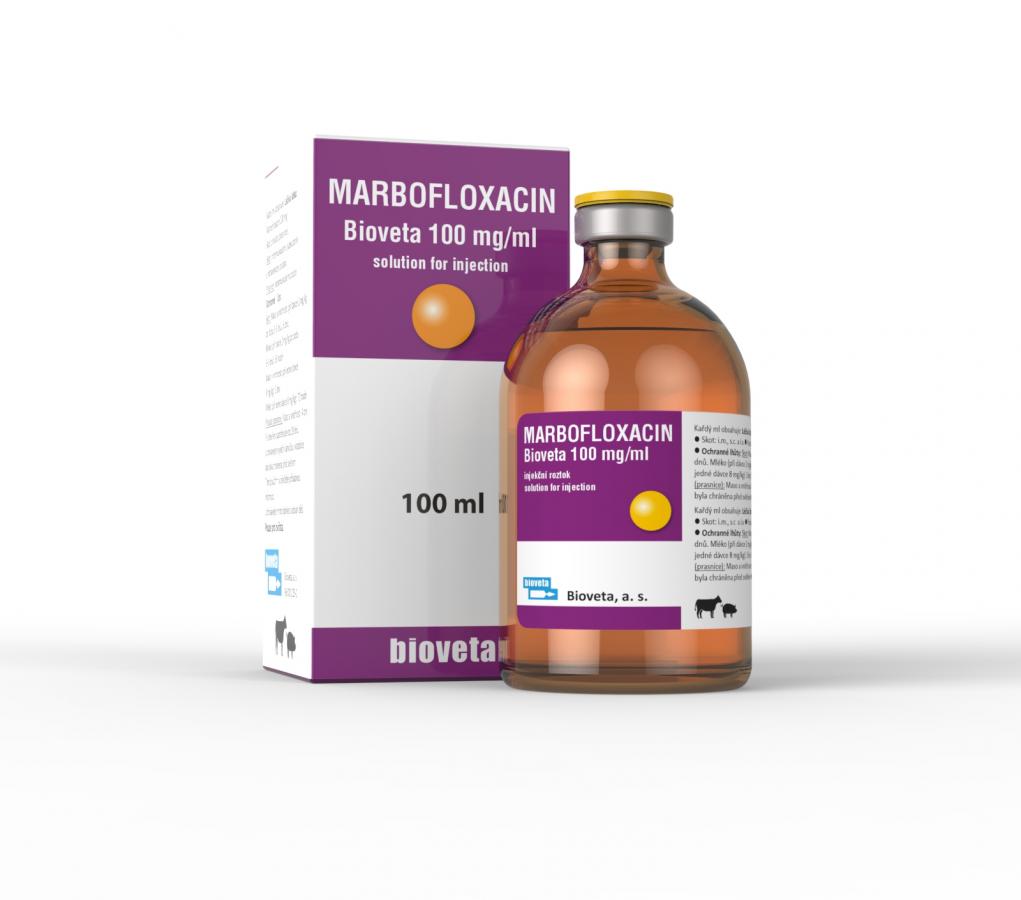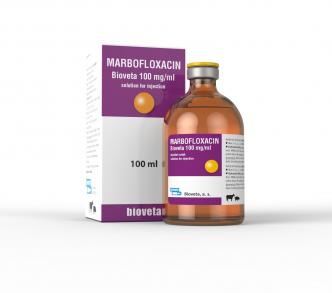Marbofloxacin Bioveta 100 mg/ml solution for injection
Homepage Products Veterinary products Marbofloxacin Bioveta 100 mg/ml solution for injection
Marbofloxacin Bioveta 100 mg/ml injectable solution – for the treatment of infectious diseases of the respiratory tract caused by organisms sensitive to marbofloxacin (Pasteurella multocida, Mannheimia haemolytica, and Mycoplasma bovis), and for the treatment of acute mastitis caused by Escherichia coli in cattle, as well as the PDS (formerly MMA) syndrome in sows.
| type of preparative: | Antimicrobial products |
|---|---|
| target species animals: | Pig, Cattle |
QUALITATIVE AND QUANTITATIVE COMPOSITION
Each ml contains:
Active substance:
Marbofloxacin 100 mg
Excipients:
|
Qualitative composition of excipients and other constituents |
Quantitative composition if that information is essential for proper administration of the veterinary medicinal product |
|
Disodium edetate |
0.11 mg |
|
Monothioglycerol |
1.0 mg |
|
Metacresol |
2.0 mg |
|
Gluconolactone |
|
|
Water for injections |
|
Yellow-greenish to yellow-brownish clear solution.
CLINICAL INFORMATION
Target species
Cattle, pigs (sows)
Indications for use for each target species
Cattle
Treatment of infectious diseases of the respiratory tract caused by strains of Pasteurella multocida, Mannheimia haemolytica and Mycoplasma bovis susceptible to marbofloxacin.
Treatment of acute mastitis caused by Escherichia coli strains susceptible to marbofloxacin during the lactation period.
Pigs (sows)
Treatment of Postpartum Dysgalactia Syndrome (PDS) (formerly MMA, metritis, mastitis, agalactia) caused by bacterial strains susceptible to marbofloxacin.
3.3 Contraindications
Do not use in cases of resistance to other fluoroquinolones (cross resistance).
Do not use in cases of hypersensitivity to the active substance, to any other quinolone or to any of the excipients.
Special warnings
Cross-resistance has been shown between marbofloxacin and other fluoroquinolones. Use of the marbofloxacin should be carefully considered when susceptibility testing has shown resistance to other fluoroquinolones because its effectiveness may be reduced.
Special precautions for use
Special precautions for safe use in the target species:
Use of the product should be based on identification and susceptibility testing of the target pathogen(s). If this is not possible, therapy should be based on epidemiological information and knowledge of susceptibility of the target pathogens at farm level, or at local/regional level.
Use of the product should be in accordance with official, national and regional antimicrobial policies.
Fluoroquinolones should be reserved for the treatment of clinical conditions which have responded poorly, or are expected to respond poorly, to other classes of antimicrobials. Whenever possible, fluoroquinolones should only be used based on susceptibility testing.
Use of the product deviating from the instructions given in this Summary of Product Characteristics (SPC) may increase the prevalence of bacteria resistant to marbofloxacin and may decrease the effectiveness of treatment with other fluoroquinolones due to the potential for cross-resistance.
Marbofloxacin belongs to category B according to the AMEG classification. An antibiotic with a lower risk of antimicrobial resistance selection (lower AMEG category) should be used for first line treatment where susceptibility testing suggests the likely efficacy of this approach.
The feeding of waste milk containing residues of marbofloxacin to calves should be avoided up to the end of the milk withdrawal period (except during the colostral phase), because it could select antimicrobial-resistant bacteria within the intestinal microbiota of the calf and increase the faecal shedding of these bacteria.
Special precautions to be taken by the person administering the veterinary medicinal product to animals:
People with known hypersensitivity to (fluoro)quinolones should avoid contact with the veterinary medicinal product.
Avoid accidental self-injection. In case of accidental self-injection seek medical advice immediately and show the package leaflet or label to the physician.
Avoid contact of the skin and eyes with the product. In case of accidental spillage onto skin or eyes, rinse the affected area with plenty of clean water.
Marbofloxacin may affect the unborn child and negatively influence reproductive functions. Pregnant women or people attempting to conceive should administer this product with caution.
Wash hands after use.
Special precautions for the protection of the environment:
Not applicable.
Adverse events
Local tolerability in cattle is better with subcutaneous applications than with intramuscular ones.
Cattle, pigs (sows):
|
Undetermined frequency (cannot be estimated from the available data) |
Application site swelling1 Application site pain1 |
1 Transient local reaction which may persist for at least 12 days after injection.
Reporting adverse events is important. It allows continuous safety monitoring of a veterinary medicinal product. Reports should be sent, preferably via a veterinarian, to either the marketing authorisation holder <or its local representative> or the national competent authority via the national reporting system. See the package leaflet for respective contact details.
Use during pregnancy, lactation or lay
Pregnancy:
Can be used during pregnancy.
Interaction with other medicinal products and other forms of interaction
None known.
Administration routes and dosage
For intramuscular, subcutaneous and intravenous use in cattle.
For intramuscular use in sows.
Pigs (sows)
Intramuscular administration of 2 mg of marbofloxacin per 1 kg of body weight (1 ml of veterinary medicinal product/50 kg bw) once daily for 3 consecutive days.
Cattle
Respiratory infections:
Single intramuscular injection of 8 mg of marbofloxacin per 1 kg of body weight (4 ml of veterinary medicinal product/50 kg bw).
A dosing regimen of 2 mg of marbofloxacin/kg of body weight once daily for 3-5 consecutive days should be used for specific cases e.g. where initial IV administration is required, or in the presence of mycoplasma caused infections.
Acute mastitis:
Subcutaneous or intramuscular administration of 2 mg of marbofloxacin per 1 kg of body weight (1 ml of veterinary medicinal product/50 kg bw) once daily for 3-5 consecutive days. The first dose can be administered intravenously.
To ensure administration of a correct dose, body weight should be determined as accurately as possible, to avoid underdosing.
If the volume into one injection site exceeds 20 ml, the dose should be divided into two or more injection sites.
The stopper may be punctured up to 30 times.
Symptoms of overdose (and where applicable, emergency procedures and antidotes)
Overdose symptoms have been reported after administration of three times the recommended dose.
Overdose may cause symptoms such as acute nervous system disorders, which should be treated symptomatically.
Special restrictions for use and special conditions for use, including restrictions on the use of antimicrobial and antiparasitic veterinary medicinal products in order to limit the risk of development of resistance
Not applicable.
Withdrawal periods
Cattle: Meat and offal (at a dose of 2 mg/kg for 3-5 days): 6 days
Milk (at a dose of 2 mg/kg for 3-5 days): 36 hours
Meat and offal (at a single dose of 8 mg/kg): 3 days
Milk (at a single dose of 8 mg/kg): 72 hours
Pigs (sows): Meat and offal: 4 days
PHARMACOLOGICAL INFORMATION
ATCvet code: QJ01MA93
Pharmacodynamics
Marbofloxacin is a synthetic, bactericidal antimicrobial, belonging to the fluoroquinolone group. Its mechanism of action is the inhibition of DNA gyrase and topoisomerase IV activity. Its broad spectrum of action includes Gram-positive bacteria (mainly Staphylococcus spp.), Gram-negative bacteria (Escherichia coli, Pasteurella spp., Mannheimia haemolytica) and mycoplasmas (Mycoplasma bovis). Resistance can occur in streptococci.
Strains with MIC ≤ 0.25 µg/ml are considered susceptible, strains with MIC 0.5-1 µg/ml are considered intermediate, while strains with MIC ≥ 2 µg/ml are considered resistant, taking into account the clinical breakpoints given for Pasteurella multocida, Mannheimia haemolytica and Histophilus somni in bovine respiratory diseases for enrofloxacin (CLSI VET01S, 7th Edition, 2024).
The susceptibility of E.coli isolated from bovine mastitis to enrofloxacin/marbofloxacin in various EU regions (CZ, FR, UK, SE) in the years 2017-2021 was very high (above 97 %).
Resistance to fluoroquinolones occurs as a result of the following mutational mechanisms at the chromosomal level: mutations in genes encoding enzymes responsible for binding at the molecular level (especially mutations in the gyrA and parC genes), a decrease in the permeability of the bacterial cell wall, a change in the expression of genes encoding efflux pumps. Plasmid-mediated resistance to fluoroquinolones causes only reduced susceptibility of bacteria, but may facilitate the development of mutations in target enzyme genes and may be transmitted horizontally. Depending on the underlying mechanism of resistance, cross-resistance to other (fluoro)quinolones and co-resistance to antimicrobials from other pharmacological groups may occur.
Pharmacokinetics
Marbofloxacin is rapidly absorbed in cattle and pigs after subcutaneous or intramuscular administration at the recommended dose of 2 mg/kg bw, reaching a peak plasma concentration of 1.5 μg/ml after less than 1 hour. Marbofloxacin is rapidly absorbed in cattle after intramuscular administration at the recommended dose of 8 mg/kg bw, reaching a peak plasma concentration of 7.3 μg/ml (Cmax) after 0.78 h (Tmax). Its biological availability is almost 100%.
Only a small fraction of marbofloxacin is bound to plasma proteins (<10% in pigs and <30% in cattle). It penetrates very well into all body tissues. In the main tissues - organs (liver, kidneys, skin, lungs, bladder, uterus) the concentration of marbofloxacin is higher than in plasma.
Marbofloxacin is eliminated more slowly in calves with an undeveloped rumen (t½ = 5-9 hours) and in pigs (t½ = 8-10 hours), but faster in cattle with a developed rumen (t½ = 4-7 hours). It is excreted mainly in an effective form in urine and faeces.
PHARMACEUTICAL PARTICULARS
Major incompatibilities
In the absence of compatibility studies, this veterinary medicinal product must not be mixed with other veterinary medicinal product.
Shelf life
Shelf life of the veterinary medicinal product as packaged for sale: 3 years.
Shelf life after first opening the immediate packaging: 28 days.
Special precautions for storage
Keep the vial in the outer carton in order to protect from light. This veterinary medicinal product does not require any special temperature storage conditions.
Nature and composition of immediate packaging
100 ml Type II brown glass vial sealed with bromobutyl rubber stopper and flip-off aluminium cap.
Vials are inserted into a folding cardboard box.
Special precautions for the disposal of unused veterinary medicinal products or waste materials derived from the use of such products
Medicines should not be disposed of via wastewater or household waste.
Use take-back schemes for the disposal of any unused veterinary medicinal product or waste materials derived thereof in accordance with local requirements and with any national collection systems applicable to the veterinary medicinal product concerned.










